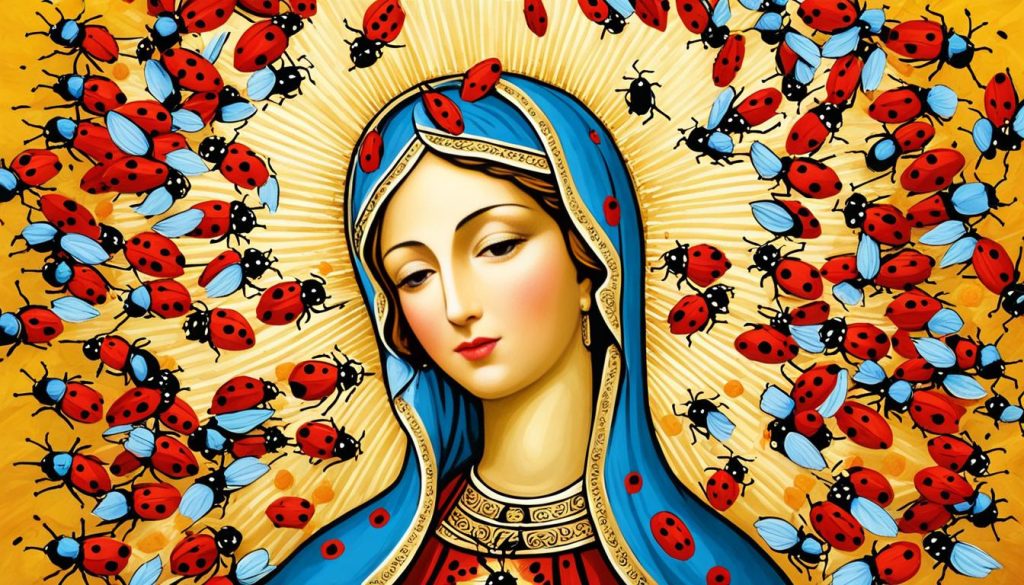Ladybugs, those delicate creatures adorned with vibrant red and black wings, have captivated human fascination for centuries. While their presence is often welcomed as a sign of good luck or simply admired for their beauty, ladybugs hold a deeper spiritual significance in Christianity. In this article, we will delve into the biblical meaning of ladybugs and explore their role as spiritual symbols in the Christian faith.
Key Takeaways:
- Ladybugs are not solely associated with the Virgin Mary but have connections to various cultures and religions.
- In Christian faith, ladybugs are seen as divine messengers and servants of God.
- Ladybugs are believed to be under the protection of the Virgin Mary and are associated with bringing gifts and good fortune.
- They hold symbolic meanings in different cultures, representing a loving relationship with God or divine figures.
- Ladybugs are also connected to the sun, weather forecasts, and personal spiritual experiences.
Ladybugs and Their Symbolism in Different Cultures
Ladybugs have long been associated with symbolic meanings in various cultures around the world. Let’s explore some of the names given to ladybugs and their significance in different cultures:
- Boarina del Signor: In certain regions of Italy and Sweden, ladybugs are referred to as “Boarina del Signor,” which translates to “shepherdess of Christ.” This name reflects their connection with a divine presence in Christian symbolism.
- Indragopa: In Sanskrit, ladybugs are known as “Indragopa,” which translates to “Indra’s shepherd.” Indra is a prominent deity in Hindu mythology, and the association with ladybugs suggests their role as protectors or guardians.
- Jungfru Marias nyckelpiga: In Swedish, ladybugs are called “Jungfru Marias nyckelpiga,” which means “Our Lady’s servant in charge of the keys.” This name highlights the ladybug’s role as a servant of the Holy Virgin Mary.
- Arca de Dios: In Spanish, ladybugs are referred to as “Arca de Dios,” which translates to “the ark of God.” This name emphasizes their spiritual significance and connection to a higher power.
These are just a few examples of the diverse names given to ladybugs in different cultures. Ladybugs have often been associated with divinities since ancient times and have been assimilated into various religious and spiritual practices.
Table:
| Culture | Ladybug Name | Meaning/Significance |
|---|---|---|
| Italian/Swedish | Boarina del Signor | Shepherdess of Christ |
| Sanskrit | Indragopa | Indra’s shepherd |
| Swedish | Jungfru Marias nyckelpiga | Our Lady’s servant in charge of the keys |
| Spanish | Arca de Dios | The ark of God |
Ladybugs as Protectors and Bringers of Good Things
Ladybugs hold a special place in Christian folklore, where they are believed to live under the protection of the Virgin Mary. Killing a ladybug is said to anger Mary for nine days, highlighting their sacred connection to her. These charming insects are not just mere creatures; they are seen as divine messengers, carrying gifts from the natural world.
In Christian traditions, ladybugs are associated with bringing gifts to the holy family. According to folklore, ladybugs bring oil to Jesus, wine to Mary, and bread to God the Father. These gifts symbolize abundance, nourishment, and blessings bestowed upon the divine family. Ladybugs are believed to be heavenly emissaries who deliver these precious offerings.
“Ladybugs are heavenly messengers carrying gifts, whether it be oil, wine, or bread. They bring blessings and abundance to the holy family.”
But it’s not just the divine family that receives gifts from ladybugs. These delightful insects are also associated with bringing gifts to humans. Throughout history, ladybugs have been known to deliver clothes, pots, and even jewels to those they favor. These gifts are often described as golden, mirroring the ladybug’s brilliant hues and giving rise to the nickname ‘goldie bird’ in some parts of England.
Ladybugs hold strong associations with fertility as well. In certain regions of Italy, they are lovingly called ‘little midwives.’ This name reflects the belief that ladybugs bring fertility and assist in the birth of newborns. Their presence is seen as an auspicious sign, a promise of a fruitful and blessed future.
In Summary
Ladybugs, under the protection of the Virgin Mary, are considered divine messengers and bringers of good things. They deliver gifts to the holy family and are believed to bring blessings and abundance. Ladybugs also bestow gifts upon humans, symbolizing their favor and goodwill. Additionally, their association with fertility reinforces their role as blessings in the natural world.

Ladybugs and their connection with the Sun and Weather
Ladybugs have long been associated with the sun and weather in various European cultures. In fact, they are often referred to as the “child of the sun” or the “little sun” due to their vibrant colors and sunny disposition.
But their connection with the sun goes beyond symbolism. Ladybugs have a unique behavior that makes them surprisingly accurate weather forecasters. Observant individuals have noticed that the flight directions of ladybugs can serve as an indication of future weather patterns.
When ladybugs take flight, their flight direction is believed to hold significance in predicting the weather. For instance, if a ladybug is observed flying in a specific direction, it can be interpreted as an indication of sunny weather in that particular direction.
This phenomenon has also led to the interpretation of ladybug flight directions as oracles in matters of the heart. If a ladybug flies towards the location of a person, it is believed to signify love or affection coming their way.
So, next time you spot a ladybug taking flight, take a moment to observe its direction and consider the weather or potential love that may be on the horizon.
“When ladybugs fly towards you, it’s like a little love note from nature, reminding you that love is in the air.”
To further illustrate the significance of ladybug flight directions, here is a table showing various flight directions and their corresponding interpretations:
| Flight Direction | Interpretation |
|---|---|
| North | Clear and sunny weather |
| South | Rainy or stormy weather |
| East | Favorable and pleasant weather |
| West | Windy conditions or a change in weather |
| Towards a person | Love or affection |
As ladybugs gracefully maneuver through the air, their flight directions continue to captivate and inspire wonder. Whether it’s predicting the weather or symbolizing matters of the heart, these delightful creatures remind us of the intricate connections between nature, spirituality, and our own lives.
The Origin of the Name “Ladybug” and its Religious Connotations
The name “ladybug” originates from the allusion to the Virgin Mary. The seven-spotted ladybug, Coccinella septempunctata, was the first to be linked to the Virgin Mary, as its seven spots were seen to represent the seven sorrows she suffered.
Ladybugs have also been called lady beetles, ladybirds, and ladybird beetles. In British English, ladybird is the preferred term, while historically, lady cow and cow lady were also used. Ladybug names in other languages and cultures often feature animals and divine or religious associations.
Ladybug Names in Different Cultures
| Language | Ladybug Name |
|---|---|
| French | puolette du Bon Dieu |
| Catalan | gallineta de la Mare de Deu |
| Italian | pola, pula |
| Spanish | arca de Dios |

These different names reflect the cultural and religious significance that ladybugs hold across various parts of the world, connecting them to divinity and faith.
Personal Encounters with Ladybugs and Spiritual Awakening
Many individuals have reported personal encounters with ladybugs that have awakened them to the presence of God and brought about spiritual growth. These encounters often serve as reminders of God’s presence and can lead to a deeper connection and understanding of faith.
Ladybugs have been associated with rest and the need to slow down, as seen in personal stories where ladybugs land on individuals during moments of reading or contemplation.
| Encounter | Experience |
|---|---|
| “The Restful Moment” | A ladybug landed on Maria’s book while she was taking a break in the park. As she watched the ladybug crawl across the pages, she felt a sense of peace and tranquility wash over her, reminding her to pause, reflect, and appreciate the stillness in life. |
| “Divine Guidance” | During a period of uncertainty, John spotted a ladybug perched on a leaf outside his window. He took it as a sign from God, filling him with hope and reassurance that everything would work out according to a higher plan. The ladybug’s presence reminded him to trust in divine guidance. |
| “The Unexpected Encounter” | Emily was going through a challenging time when a ladybug landed on her outstretched hand. In that moment, she felt a profound sense of comfort and love envelop her. The ladybug’s presence served as a gentle embrace from above, reminding her that she was never alone. |
These personal experiences with ladybugs highlight the spiritual significance they hold for many individuals. Whether it’s a fleeting encounter or a prolonged interaction, ladybugs can serve as powerful catalysts for personal growth and a deeper connection to the divine.
Conclusion
Ladybugs hold significant symbolism in Christianity and various cultures. They are associated with divine attributes, protection, and the bringing of gifts. Ladybugs are seen as reminders of God’s presence and invitations to experience wonder and rest. While their biblical meaning may not be exclusive to the Virgin Mary, ladybugs hold spiritual significance and serve as symbols of faith and spirituality.




2 comments